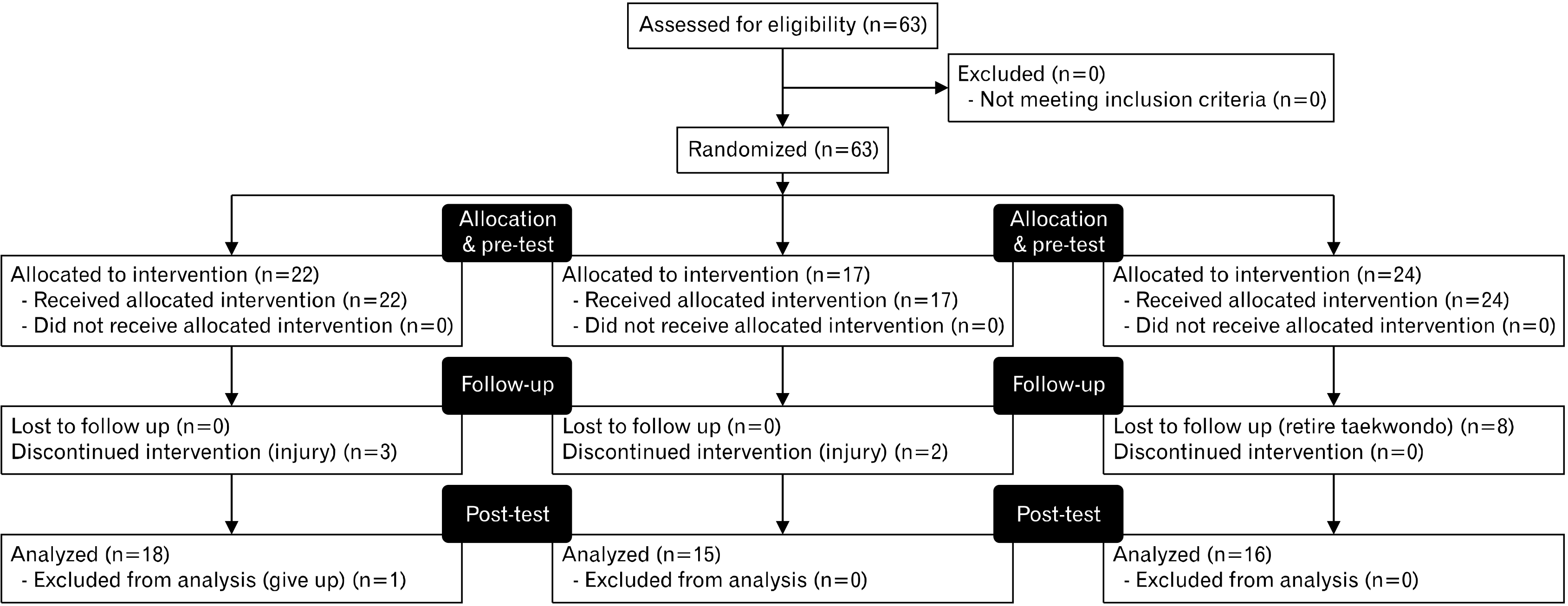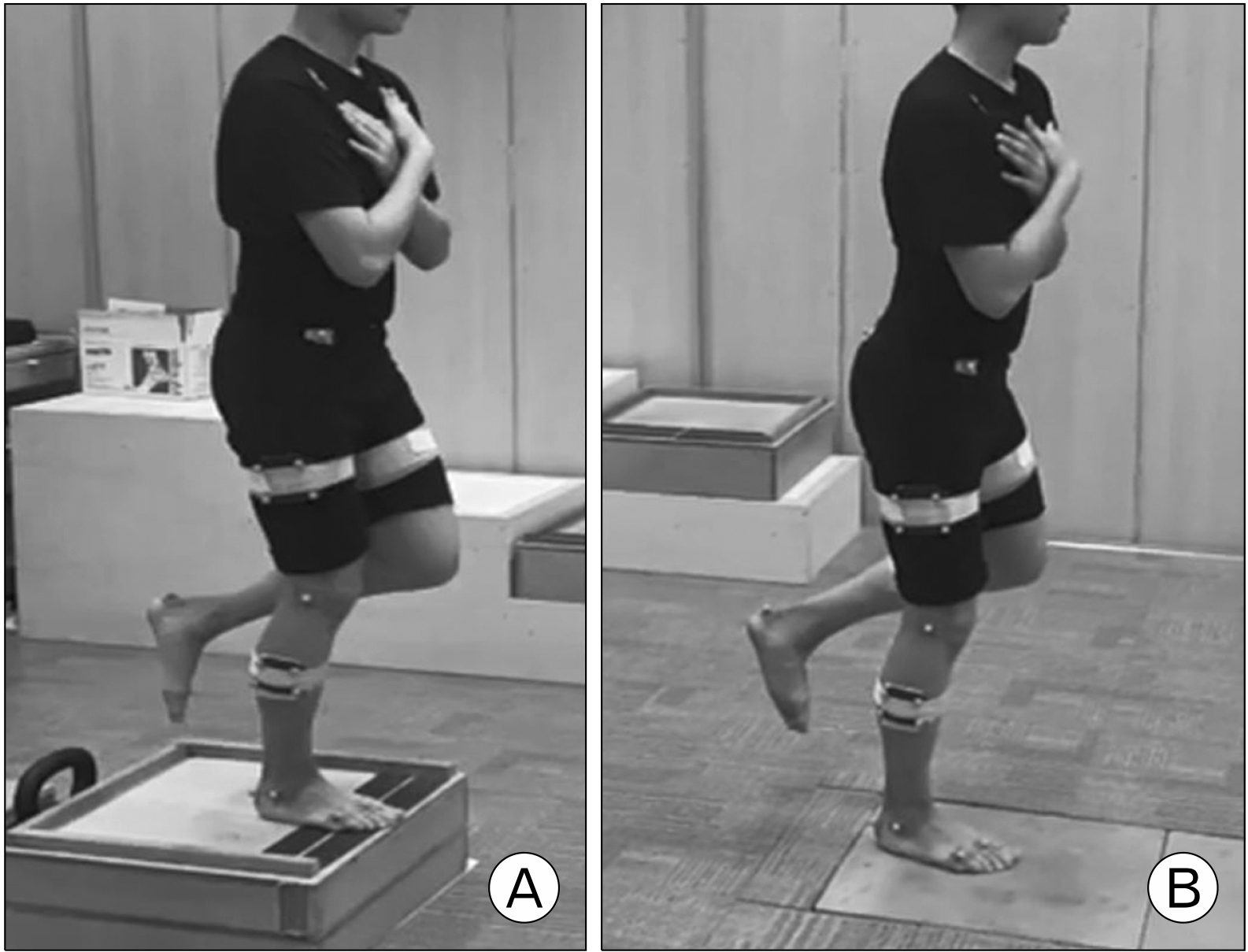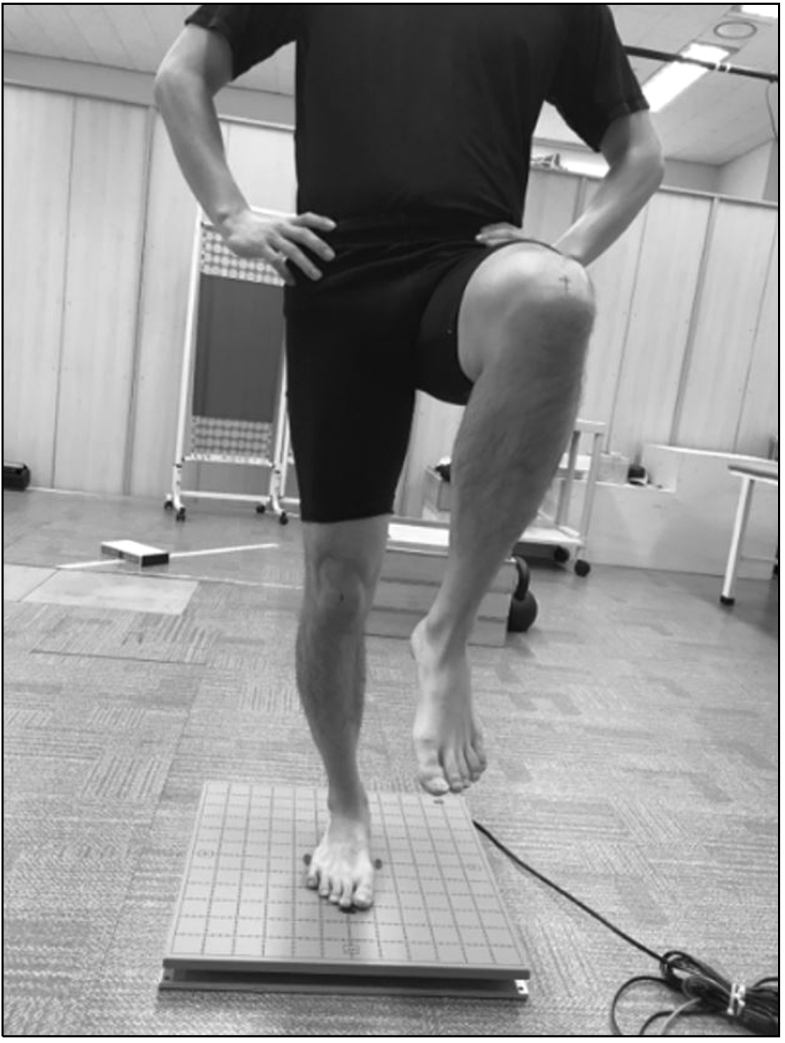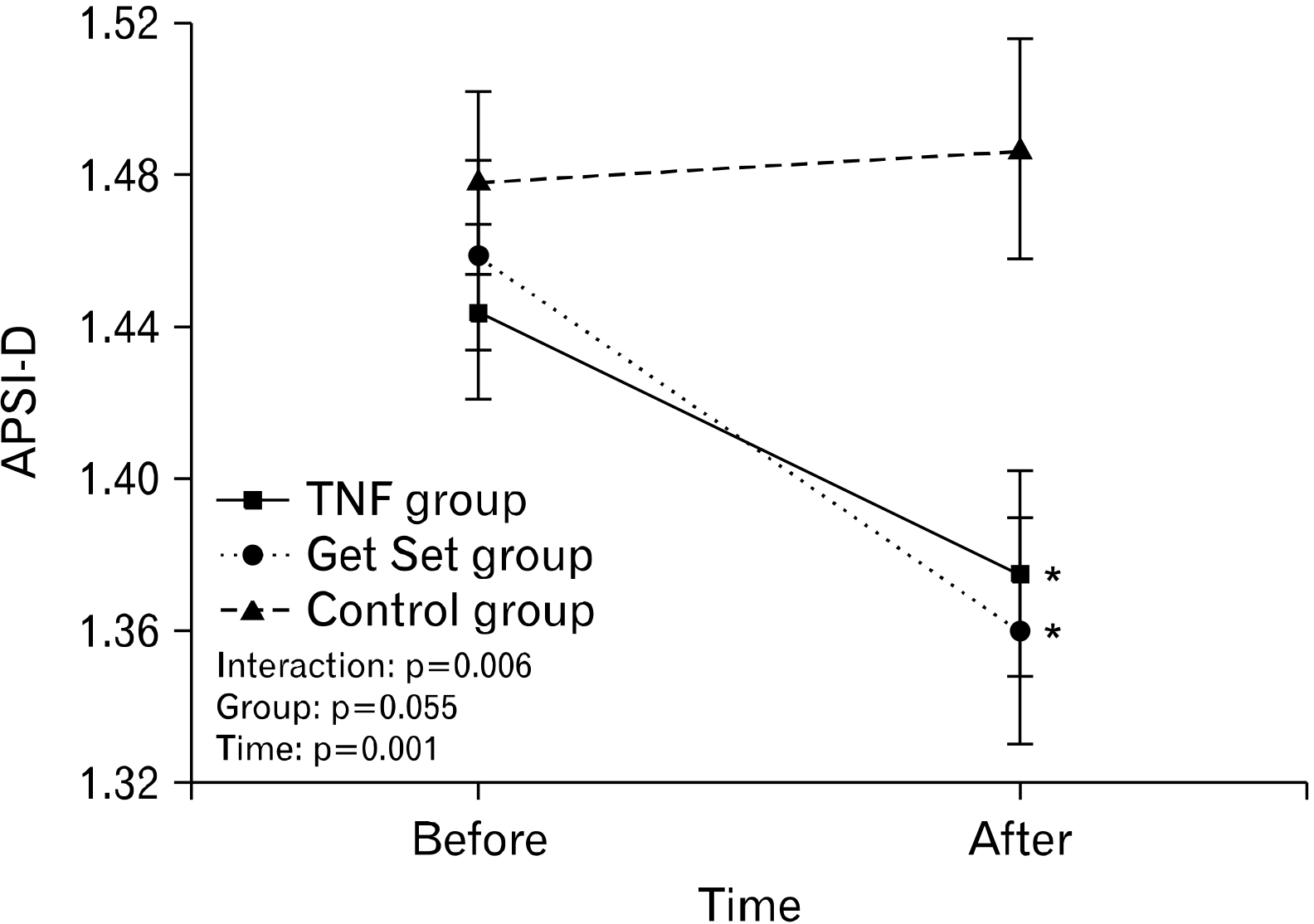1. Lystad RP, Pollard H, Graham PL. 2009; Epidemiology of injuries in competition taekwondo: a meta-analysis of observational studies. J Sci Med Sport. 12:614–21. DOI:
10.1016/j.jsams.2008.09.013. PMID:
19054714.

2. Jeong HS, Ha S, Lee SY. 2020; Injuries of Korean youth taekwondo athletes applying injury surveillance systems. J Sport Leis Stud. 82:433–440. DOI:
10.51979/KSSLS.2020.10.82.433.

4. McCall A, Carling C, Nedelec M, et al. 2014; Risk factors, testing and preventative strategies for non-contact injuries in professional football: current perceptions and practices of 44 teams from various premier leagues. Br J Sports Med. 48:1352–7. DOI:
10.1136/bjsports-2014-093439. PMID:
24837243.

5. Alentorn-Geli E, Myer GD, Silvers HJ, et al. 2009; Prevention of non-contact anterior cruciate ligament injuries in soccer players. Part 2: a review of prevention programs aimed to modify risk factors and to reduce injury rates. Knee Surg Sports Traumatol Arthrosc. 17:859–79. DOI:
10.1007/s00167-009-0823-z. PMID:
19506834.

6. Hübscher M, Zech A, Pfeifer K, Hänsel F, Vogt L, Banzer W. 2010; Neuromuscular training for sports injury prevention: a systematic review. Med Sci Sports Exerc. 42:413–21. DOI:
10.1249/MSS.0b013e3181b88d37.
7. Emery CA, Cassidy JD, Klassen TP, Rosychuk RJ, Rowe BH. 2005; Effectiveness of a home-based balance-training program in reducing sports-related injuries among healthy adolescents: a cluster randomized controlled trial. CMAJ. 172:749–54. DOI:
10.1503/cmaj.1040805. PMID:
15767608. PMCID:
PMC552888.

8. Rivera MJ, Winkelmann ZK, Powden CJ, Games KE. 2017; Proprioceptive training for the prevention of ankle sprains: an evidence-based review. J Athl Train. 52:1065–7. DOI:
10.4085/1062-6050-52.11.16. PMID:
29140127. PMCID:
PMC5737043.

9. Sañudo B, Sánchez-Hernández J, Bernardo-Filho M, Abdi E, Taiar R, Núñez J. 2019; Integrative neuromuscular training in young athletes, injury prevention, and performance optimization: a systematic review. Appl Sci. 9:3839. DOI:
10.3390/app9183839.

10. Butler RJ, Lehr ME, Fink ML, Kiesel KB, Plisky PJ. 2013; Dynamic balance performance and noncontact lower extremity injury in college football players: an initial study. Sports Health. 5:417–22. DOI:
10.1177/1941738113498703. PMID:
24427412. PMCID:
PMC3752196.

11. Yoo S, Park SK, Yoon S, Lim HS, Ryu J. 2018; Comparison of proprioceptive training and muscular strength training to improve balance ability of taekwondo poomsae athletes: a randomized controlled trials. J Sports Sci Med. 17:445–54.
12. İpekoğlu G, Erdogan CS, ER F, Baltaci G, Colakoglu FF. 2018; Effect of 12 week neuromuscular weighted rope jump training on lower extremity reaction time. Turk J Sport Exerc. 20:111–5.

15. Patti A, Messina G, Palma R, et al. 2018; Comparison of posturographic parameters between young taekwondo and tennis athletes. J Phys Ther Sci. 30:1052–5. DOI:
10.1589/jpts.30.1052. PMID:
30154599. PMCID:
PMC6110219.

16. Wikstrom EA, Tillman MD, Smith AN, Borsa PA. 2005; A new force-plate technology measure of dynamic postural stability: the dynamic postural stability index. J Athl Train. 40:305–9.
17. Huurnink A, Fransz DP, Kingma I, de Boode VA, Dieën JH. 2019; The assessment of single-leg drop jump landing performance by means of ground reaction forces: a methodological study. Gait Posture. 73:80–5. DOI:
10.1016/j.gaitpost.2019.06.015. PMID:
31302336.

18. Hertel J, Olmsted-Kramer LC, Challis JH. 2006; Time-to-boundary measures of postural control during single leg quiet standing. J Appl Biomech. 22:67–73. DOI:
10.1123/jab.22.1.67. PMID:
16760569.

19. Pau M, Porta M, Arippa F, et al. 2019; Dynamic postural stability, is associated with competitive level, in youth league soccer players. Phys Ther Sport. 35:36–41. DOI:
10.1016/j.ptsp.2018.11.002. PMID:
30419410.

20. Räisänen AM, Galarneau JM, van den Berg C, et al. 2022; Identifying predictors of response and non-response to neuromuscular training warm-up programs among youth. Osteoarthr Cartil. 30:S234. DOI:
10.1016/j.joca.2022.02.317.
21. Paillard T, Noé F. 2020; Does monopedal postural balance differ between the dominant leg and the non-dominant leg?: a review. Hum Mov Sci. 74:102686. DOI:
10.1016/j.humov.2020.102686. PMID:
33059226.

22. Myer GD, Ford KR, Brent JL, Hewett TE. 2006; The effects of plyometric vs. dynamic stabilization and balance training on power, balance, and landing force in female athletes. J Strength Cond Res. 20:345–53. DOI:
10.1519/00124278-200605000-00019. PMID:
16686562.

23. Paterno MV, Myer GD, Ford KR, Hewett TE. 2004; Neuromuscular training improves single-limb stability in young female athletes. J Orthop Sports Phys Ther. 34:305–16. DOI:
10.2519/jospt.2004.34.6.305. PMID:
15233392.

24. Bešlija T, Marinković D, Čular D. 2017; Postural stability assessment in elite taekwondo athletes: comparative study between different age group. Acta Kinesiol. 11:98–104.
25. Ha CS, Yoon JS, Kim JJ. 2011; The biomechanical analysis of the taekwondo in dollyochagi motion during the badachagi. Korean J Sport Sci. 20:1187–95.
26. McKeon PO, Ingersoll CD, Kerrigan DC, Saliba E, Bennett BC, Hertel J. 2008; Balance training improves function and postural control in those with chronic ankle instability. Med Sci Sports Exerc. 40:1810–9. DOI:
10.1249/MSS.0b013e31817e0f92. PMID:
18799992.

27. Motealleh A, Mohamadi M, Moghadam MB, Nejati N, Arjang N, Ebrahimi N. 2019; Effects of core neuromuscular training on pain, balance, and functional performance in women with patellofemoral pain syndrome: a clinical trial. J Chiropr Med. 18:9–18. DOI:
10.1016/j.jcm.2018.07.006. PMID:
31193229. PMCID:
PMC6522640.

28. Surakhamhaeng A, Bovonsunthonchai S, Vachalathiti R. 2020; Effects of balance and plyometric training on balance control among individuals with functional ankle instability. Physiother Q. 28:38–45. DOI:
10.5114/pq.2020.92474.
29. Singh A, Boyat AV, Sandhu JS. 2015; Effect of a 6 week plyometric training program on agility, vertical jump height and peak torque ratio of Indian taekwondo players. Sport Exerc Med Open J. 1:42–6. DOI:
10.17140/SEMOJ-1-107.

30. Freyler K, Krause A, Gollhofer A, Ritzmann R. 2016; Specific stimuli induce specific adaptations: sensorimotor training vs. reactive balance training. PLoS One. 11:e0167557. DOI:
10.1371/journal.pone.0167557. PMID:
27911944. PMCID:
PMC5135127.





 PDF
PDF Citation
Citation Print
Print







 XML Download
XML Download